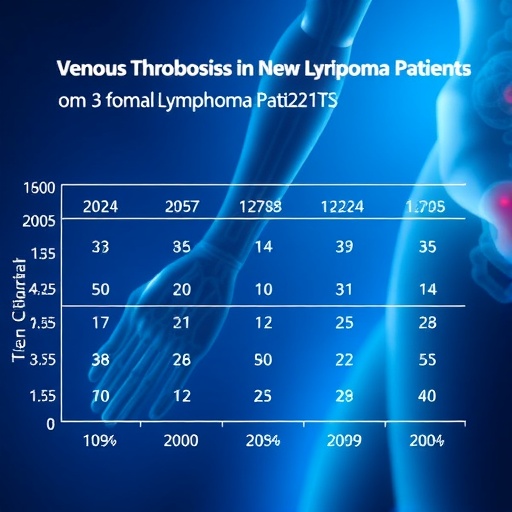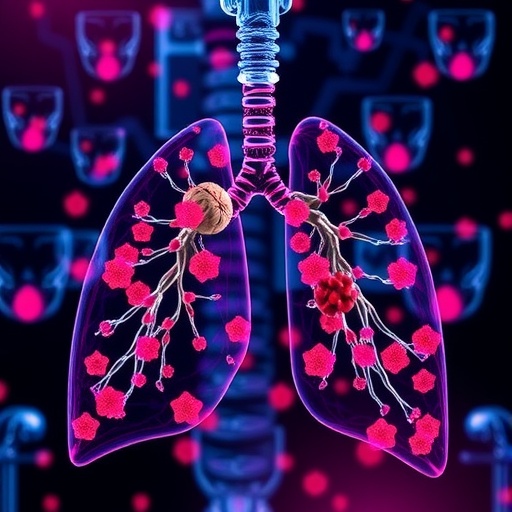In a groundbreaking study emerging from the Vietnam National Cancer Hospital, researchers have unveiled pivotal insights into the incidence and risk factors of venous thromboembolism (VTE) among newly diagnosed lymphoma patients undergoing systemic therapy. VTE, a term encompassing both deep vein thrombosis and pulmonary embolism, remains a formidable complication frequently exacerbating morbidity and mortality in oncology settings. Despite lymphoma’s recognized high-risk status for thrombotic events, data reflecting real-world VTE prevalence and predictive markers within Southeast Asia have been conspicuously scarce—until now.
The prospective observational study meticulously tracked 157 patients freshly diagnosed with Hodgkin and non-Hodgkin lymphomas between January 2022 and January 2024. Employing rigorous diagnostic criteria, the team systematically screened participants with Doppler ultrasound and computed tomography, aiming to detect VTE occurrences both at baseline and during chemotherapy cycles. This dual modality approach underscores the commitment to diagnostic accuracy and comprehensive thrombosis surveillance in a diverse patient demographic.
Findings from this Vietnamese cohort reveal an overall VTE incidence of 8.3%, a figure that is both clinically significant and reflective of the disease’s thrombogenic potential. Strikingly, the majority of VTE cases—approximately 7.0%—were diagnosed concomitantly with the initial lymphoma diagnosis, suggesting a critical window for early thrombotic risk management. Only a minority (1.3%) of thrombotic events manifested during chemotherapy, highlighting the predominance of pretreatment prothrombotic conditions in this population.
.adsslot_n7OAGdND3j{ width:728px !important; height:90px !important; }
@media (max-width:1199px) { .adsslot_n7OAGdND3j{ width:468px !important; height:60px !important; } }
@media (max-width:767px) { .adsslot_n7OAGdND3j{ width:320px !important; height:50px !important; } }
ADVERTISEMENT
Central to the study’s risk stratification framework was the application of the Khorana score, a validated predictive model commonly deployed to assess thrombosis risk in cancer patients. This scoring system integrates clinical and laboratory parameters to categorize patients into low, intermediate, and high-risk tiers. At baseline, over two-thirds of patients (68.2%) were stratified as low-risk, while a smaller fraction (7.6%) fell into the high-risk category. Notably, the proportion of high-risk patients diminished progressively as treatment advanced, potentially reflecting therapeutic modulation of thrombotic risk or shifts in clinical factors.
Delving deeper, the researchers performed multivariate logistic regression analyses to isolate independent predictors of VTE within this lymphoma cohort. Two standout variables emerged: elevated pretreatment D-dimer levels exceeding 500 ng/mL and the presence of cardiovascular comorbidities. D-dimer, a fibrin degradation product, serves as an established biomarker for coagulation activation and fibrinolysis. The study elucidates that elevated D-dimer concentrations prior to therapy initiation correlate strongly with heightened VTE risk, underscoring its utility as a prognostic biomarker in lymphoma care.
The study’s findings advocate for the integration of routine D-dimer assays and comprehensive cardiovascular evaluations into pretreatment protocols. This approach may enable oncologists to pinpoint high-risk individuals who might derive the most benefit from prophylactic anticoagulation or intensified monitoring strategies. Early identification and intervention could translate into reduced thrombotic complications, subsequently improving lymphoma treatment tolerability and overall patient outcomes.
Vietnam’s contribution through this real-world evidence enriches the global understanding of VTE risk in lymphoma, especially within underrepresented Southeast Asian populations. The data challenge the established paradigms shaped predominantly by Western cohorts and illuminate the necessity for region-specific risk assessment tools. By contextualizing thrombosis risk within the unique genomic, environmental, and healthcare landscapes of Vietnam, this research sets a precedent for tailored oncologic supportive care.
Furthermore, the predominance of VTE events detected at diagnosis rather than during chemotherapy raises provocative questions about the underlying biological mechanisms. It is plausible that tumor biology and host interactions at the time of malignancy onset trigger systemic coagulopathy before anticancer therapies exert additional influences. This temporal distribution warrants further investigation into cancer-driven hypercoagulation pathways as potential therapeutic targets.
The deployment of imaging modalities such as Doppler ultrasound and computed tomography as screening tools within this study establishes a robust diagnostic framework. While these techniques are standard in thrombosis detection, their systematic application in a prospective lymphoma cohort provides high fidelity in capturing both symptomatic and subclinical VTE events, ensuring a comprehensive epidemiological portrait.
As the oncology community increasingly recognizes the interplay between thrombosis and cancer progression, this study reinforces the imperative to intertwine hematological assessment with oncologic management. The morbidity associated with VTE not only imperils life but complicates chemotherapy delivery, potentially necessitating dose adjustments or treatment delays that undermine curative intent.
The research team’s analytical rigor and real-world design bolster the external validity of their conclusions. Prospective data collection reduces retrospective bias, and inclusion of a broad range of lymphoma subtypes reflects clinical practice heterogeneity. This granularity supports the extrapolation of findings to similar healthcare settings beyond Vietnam, particularly in resource-limited environments where VTE risk stratification and prophylaxis remain challenging.
In conclusion, the unveiling of an 8.3% VTE incidence predominantly clustered at lymphoma diagnosis, alongside the delineation of elevated D-dimer and cardiovascular comorbidities as potent risk enhancers, heralds a new chapter in personalized thromboprophylaxis. This comprehensive study navigates the intricate nexus of lymphoma pathology, coagulation biology, and clinical praxis, ultimately charting pathways to mitigate one of cancer care’s most formidable complications.
With its blend of clinical precision and epidemiological depth, this Vietnamese study not only enriches scientific discourse but also cries out for pragmatic implementation of thrombosis risk assessments in everyday oncology workflows. Through such integration, the global fight against lymphoma can evolve beyond tumor eradication to encompass holistic patient safety and quality of life.
Subject of Research: Venous thromboembolism risk assessment and incidence in newly diagnosed lymphoma patients receiving systemic therapy.
Article Title: Venous thromboembolism risk in newly diagnosed lymphoma patients: a real-world prospective observational study from Vietnam National Cancer Hospital.
Article References:
Nguyen, T.T.H., Do, H.N., Le, T.Y. et al. Venous thromboembolism risk in newly diagnosed lymphoma patients: a real-world prospective observational study from Vietnam National Cancer Hospital. BMC Cancer 25, 1301 (2025). https://doi.org/10.1186/s12885-025-14719-3
Image Credits: Scienmag.com
DOI: https://doi.org/10.1186/s12885-025-14719-3
Tags: cancer morbidity and mortality factorsdeep vein thrombosis in cancerdiagnostic criteria for venous thromboembolismearly thrombotic risk managementHodgkin lymphoma thrombotic eventsnon-Hodgkin lymphoma VTE prevalencepulmonary embolism and lymphomaSoutheast Asia cancer studiessystemic therapy and thromboembolismthrombosis surveillance in oncologyvenous thrombosis risk lymphoma patientsVTE incidence in lymphoma





